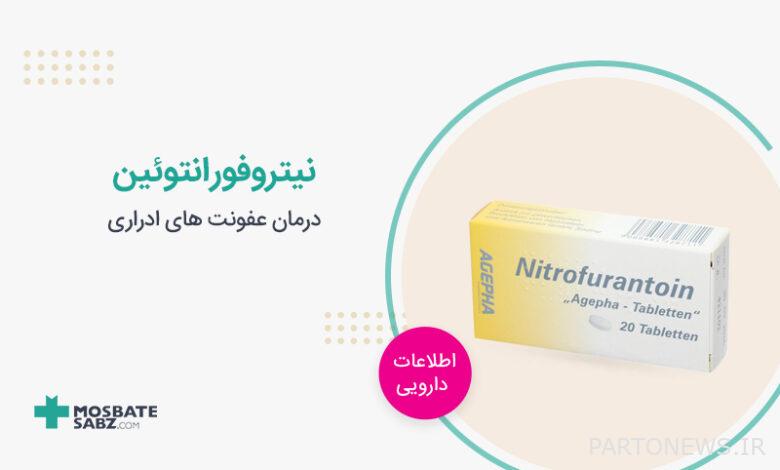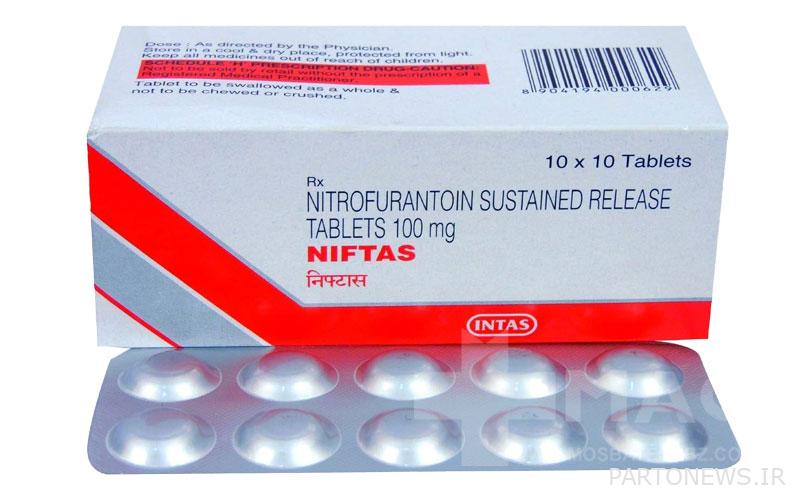What is nitrofurantoin? Complications and benefits of Nitrofurantoin drug

Urinary tract infections (UTIs) are one of the most common infections in the world that can occur in any part of the urinary tract, including the kidneys, bladder, ureters, and urethra. Nitrofurantoin is a bactericidal antibiotic that works by inhibiting the production of energy in bacteria. This prevents bacteria from surviving and multiplying. This drug is produced and marketed in different pharmaceutical forms, including capsules and oral suspension. In the following, we will discuss the mechanism of action, pharmaceutical forms, uses, method of administration, precautions and contraindications of nitrofurantoin.
What we read in this article
Pharmaceutical forms of nitrofurantoin
- Capsules, large crystals: 25 mg, 50 mg and 100 mg
- Capsule, monohydrate/macrocystal: 100 mg
- Oral suspension: 25 mg/5 ml
Nitrofurantoin uses
Nitrofurantoin is used to treat or prevent some urinary tract infections. This drug is an antibiotic that works by stopping the growth of bacteria. It does not work for viral infections (such as colds, flu). Unnecessary use or overuse of any antibiotic can reduce its effectiveness. Because of the risk of developing a specific blood problem (hemolytic anemia), children younger than one month should not use nitrofurantoin.
- The biggest changes that will happen in WhatsApp this yearFebruary 3, 2024
- Applications for locating family and friends on AndroidFebruary 2, 2024
Pharmacological effects and mechanism of action of nitrofurantoin drug
It inactivates or alters bacterial ribosomal proteins and other macromolecules that may interfere with metabolism and cell wall synthesis. Absorption of this drug is good, and the macrocrystalline form is absorbed more slowly (causing less GI upset) due to slower dissolution. It is reduced by bacterial flavoproteins to reactive intermediates, and body tissues (except plasma) metabolize 60% of the drug to inactive metabolites. Excretion of this drug is done through urine (40%) and feces (small amount).
Dosage of nitrofurantoin
Take nitrofurantoin orally with food or milk as directed by your doctor. This medicine is usually taken four times a day to treat an infection or once a day at bedtime to prevent an infection. Avoid taking antacids containing magnesium trisilicate while taking this medicine. Antacids containing magnesium trisilicate bind with nitrofurantoin and prevent its complete absorption. The dose and duration is based on your medical condition and response to treatment. Also, in children, the dose based on weight is prescribed by the doctor.
Time to use nitrofurantoin
Before taking nitrofurantoin drug, carefully check the drug information on the package (including cases and how to use) of the drug. For best effect, take this antibiotic at equal times. When taking this medication to prevent infection, take it exactly as directed by your doctor. Tell your doctor if you have symptoms of a new urinary tract infection (such as pain while urinating). If you are taking this medicine to treat an infection, continue taking this medicine until the prescribed dose is finished, even if you have symptoms.
How to use nitrofurantoin in adults
- Nitrofurantoin drug is used for urinary tract infection in sensitive strains of Escherichia coli, Enterobacter, Klebsiella, Staphylococcus aureus and Staphylococcus saprophyticus.
- Macrocrystals (Macrodantin, Furadantin, and equivalents): 50-100 mg orally every 6 hours for 7 days or for 3 days after sterile urine is obtained.
- Monohydrate/macrocrystals (Macrobid and equivalents): 100 mg orally every 12 hours for 7 days or for 3 days after sterile urine is obtained.
- Long-term prevention/suppression: 50-100 mg of coarse crystals taken orally for up to 12 months.
How to use nitrofurantoin in children
- For the treatment of urinary tract infection in children older than 1 month, 5-7 mg/kg is used every 6 hours for 7 days. Also, 1-2 mg/kg orally or in 2 divided doses are used to prevent urinary tract infections.
- In people over 12 years of age, macrocrystals (Macrodantin, Furadantin and equivalents): 50-100 mg orally every 6 hours for 7 days or for 3 days after obtaining sterile urine.
- Monohydrate/macrocrystals (Macrobid and equivalents): 100 mg orally every 12 hours for 7 days or for 3 days after sterile urine is obtained.
- Long-term prevention/suppression: 50-100 mg of coarse crystals orally for up to 12 months.
Precautions
Before taking nitrofurantoin, if you are allergic to it or any other ingredients in the medicine, avoid using it. This medicine may contain inactive ingredients that can cause allergic reactions or other problems. If you have a medical history including kidney disease, liver disease (including liver problems caused by nitrofurantoin in the past), a specific genetic disease (G-6). – PD deficiency), some blood disorders (such as anemia), lung diseases, some neurological problems (peripheral neuropathy), some eye diseases (optic neuritis), diabetes, untreated mineral imbalances, vitamin B deficiency, etc. Consult a doctor.
Nitrofurantoin may cause live bacterial vaccinia. Before having any immunizations/vaccinations, tell your healthcare professional that you are using nitrofurantoin. Elderly people may be at greater risk for side effects when using this drug, especially nerve, liver, or lung problems. Do not use this medicine in the near future or during childbirth (38 to 42 weeks of pregnancy) due to possible harm to the baby, such as a specific blood problem (hemolytic anemia). This drug passes into breast milk and may have adverse effects on breastfed infants less than one month old and infants with certain genetic conditions (G-6-PD deficiency).
- Use the drug with caution in patients with G6PD deficiency (may increase the risk of hemolytic anemia).
- Avoid long-term use in the elderly (may increase risk of pulmonary toxicity).
- Peripheral neuropathy has been reported in some patients, increased in patients diagnosed with anemia, diabetes, B vitamin deficiency, or electrolyte imbalance (caution).
- Acute/chronic pulmonary reactions (eg, cough, interstitial pneumonitis, or fibrosis) have been reported.
- Bacterial superinfections may occur with long-term treatment.
Contraindications to the use of nitrofurantoin
- Renal failure (anuria, oliguria or CrCl <60 ml/min)
- Pregnancy at term (38-42 weeks of pregnancy)
- History of hepatic dysfunction/cholestatic jaundice with nitrofurantoin
- Babies (less than 28 days)
- Hypersensitivity
side effects of nitrofurantoin
Diarrhea, cough, dizziness, drowsiness, shortness of breath, exfoliative dermatitis, fatigue, flatulence, headache, hemolytic anemia, hepatitis, etc. are some of the side effects of nitrofurantoin. Take this medicine with food to minimize nausea. If any of these effects persist or worsen, tell your doctor or pharmacist right away. This medicine may rarely cause very serious (possibly fatal) lung problems. Lung problems occur during the first month of treatment or after long-term use of nitrofurantoin (generally for 6 months or more).
Some of the serious side effects of nitrofurantoin include nausea/vomiting that won’t stop, unusual tiredness, dark urine, yellow eyes/skin, fast/fast heartbeat, cough that won’t go away, chest pain, shortness of breath/ Breathing problem, joint/muscle pain, bluish/purple skin, etc. Using this medicine for long or frequent periods may lead to oral thrush or a new vaginal yeast infection (such as oral or vaginal yeast infection). Contact your doctor if you notice white spots in the mouth, change in vaginal discharge or observation.
- Anorexia
- Arthralgia
- Chest pain
- Cough
- diarrhea
- Dizziness and headache
- Drowsiness
- Shortness of breath
- tiredness
- Flatulence
- Hemolytic anemia
- hepatitis
- itching
- nausea

Drug interactions of nitrofurantoin
- Class X interactions (avoidance): BST (intravesical), cholera vaccine, magnesium trisilicate, norfloxacin
- Reduction of the effects of drugs by nitrofurantoin: BCG (intravesical), BCG vaccine (immunogenic), cholera vaccine, lactobacillus and estriol, norfloxacin, sodium picosulfate, typhoid vaccine
- Enhancement of drug effects by nitrofurantoin: eplerenone, local anesthetics, prilocaine, sodium nitrite
- Increased effects of nitrofurantoin by drugs: dapsone (topical), nitric oxide, probenecid
Taking nitrofurantoin tablets during pregnancy and breastfeeding
Nitrofurantoin tablets are not recommended during pregnancy. This drug is an antibiotic used to treat urinary tract infections. Studies have shown that taking nitrofurantoin in the first trimester of pregnancy may increase the risk of birth defects. Also, taking this medicine in the last week of pregnancy may increase the risk of jaundice in babies. Pregnant women and nursing mothers should use different types of antibiotics during pregnancy only with a doctor’s prescription and approval.
Nitrofurantoin storage conditions
Nitrofurantoin should be stored at room temperature away from light and moisture. Also, it should be kept away from children and animals as much as possible, and if it breaks down or expires, dispose of it properly.
The last word of nitrofurantoin drug
A urinary tract infection (UTI) is an infection that affects the urinary tract and can occur anywhere in the urinary tract. Bladder infection (cystitis) is the most common type of urinary tract infection, followed by kidney infection (pyelonephritis), a more serious infection that can cause more serious complications. Urinary tract infection is caused by the introduction of bacteria into the urinary tract through sexual intercourse, the use of urinary medical devices, or in pregnant women due to hormonal changes. In this article from the Green Positive Online Pharmacy magazine, we introduced the drug Nitrofurantoin to fight against urinary infections.
Site source: Medscape

